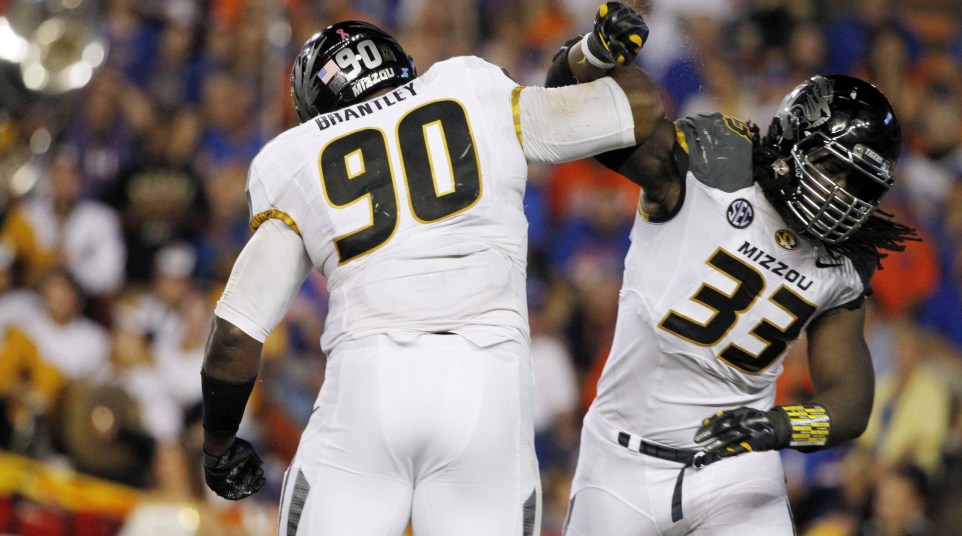Season-long report card: Missouri
OFFENSE: C-
Maty Mauk’s season can only be classified as a disappointment, though reports have it that he wasn’t 100 percent healthy during the middle portion of the year.
Still, he threw 13 interceptions and only completed 53.4 percent of his passes, bailing from the pocket way too often and taking too many risks. He also didn’t prove as much of a weapon as a runner as many anticipated. Instead of challenging for an All-SEC position, he fell into a middle tier just above the conference’s worst.
Bud Sasser emerged as a legitimate No. 1 option, but Jimmie Hunt and Darius White hardly approximated last season’s Big Three, and the team got only marginally-better passing-game production at tight end and running back (a combined 386 receiving yards for Marcus Murphy and Sean Culkin).
The running game was the saving grace most of the season, but not spectacular. Russell Hansbrough and Murphy combined for more than 2,000 rushing yards on better than 5.2 yards per carry.
The team’s offensive line had to replace its starting left tackle and deal with an early season-ending injury and the subsequent lineup shuffling. The unit played its best at the end of the season, but went through too many inconsistencies to get high marks.
DEFENSE: B+
Shane Ray, Markus Golden and a trio of athletic defensive tackles combined to give Missouri the SEC’s best pass rush by far. The two defensive ends also played better than expected against the run and put themselves in good position for the upcoming NFL draft.
The team’s run defense finished in the top third in the SEC, as the defensive tackles — likely the strength of next year’s Mizzou defensive line — did a much better job at the point of attack during the second half of the season.
Michael Scherer and Kentrell Brothers matured into above-average SEC linebackers and combined for 236 tackles. The pair aren’t ideal in terms of playing physical and shedding blocks, but they make up for it with decent instincts and good speed. It helps to play behind such a good defensive line as well.
Cornerback Aarion Penton played just OK and didn’t progress as quickly as some hoped before the season, but junior college transfer Kenya Dennis earned Gary Pinkel’s trust as the season wore on, and safety Braylon Webb also played a strong second half of the season to overcome a slow start and finish as perhaps the unit’s best player.
Just like on offense, depth was the biggest issue for Mizzou in 2014, as absences by any of the key starters constituted major drop-offs in performance (see: Golden’s hamstring problem). Just one year ago, Ray and Golden, for instance, were backups. How good was that 2013 group of defensive ends?
SPECIAL TEAMS: B+
Murphy finished first-team All-SEC as a returner, leading the conference in kickoff return average and producing three special teams touchdowns. He arguably finished his career as Missouri’s best returner ever, ahead of current Philadelphia Eagles receiver Jeremy Maclin.
Missouri’s punt and kick coverage was just OK, and the Tigers were the SEC’s worst in terms of allowing long kickoff returns. Granted, the SEC features two Ray Guy Award finalists in Alabama’s JK Scott and Texas A&M’s Drew Kaser, but Missouri’s Christian Brinser finished near the bottom of the league in most punting categories.
Placekicker Andrew Baggett made two kicks of 50+ yards in a crucial win against Arkansas in the regular-season finale, then finished 4 for 4 in the SEC championship and the bowl game combined to offset a somewhat shaky season.
COACHING: B+
Missouri probably lost as much starting talent as any Top 15 team from 2014. This year’s Tigers were flawed, clearly less potent on offense, more inexperienced and thinner than last year’s squad.
Yet Gary Pinkel again did a masterful job of developing his players. The team could’ve nose-dived mid-season, but it stayed together for a fourth-quarter comeback at South Carolina and didn’t let an embarrassing 34-0 home loss to Georgia shake its confidence. The coaching staff identified the strengths and weaknesses of this team and evolved as the season went on to maximize overall production.
The staple of this program has become that it finds a way to win every game it should, week-in and week-out. You’d better put Top 10 talent on the field if you want to beat one of Pinkel’s teams, because you have to earn it.
The team hired offensive line coach A.J. Ricker in July, and it took a while to get things sorted at that position. The only other knock on this group is that despite superior player development and back-to-back division titles, this team continues to rank near the bottom of the SEC in recruiting.
This program could very well win a national championship if it just had an extra handful or two of four- and five-star recruits.
OVERALL: A
This team got beaten handily in the SEC championship game for a second consecutive season, and suffered a painful home loss to Indiana that looked silly by the end of the season.
But to win back-to-back SEC East titles after most media slotted the Tigers for a fourth-place finish (certainly behind South Carolina and Georgia)? That’s an outstanding result for a program and a fan base still pining for full-on acceptance in the media and around the SEC as an annual contender.
Before the season, it seemed like Mauk would have to carry this team, but he didn’t make much progress after a red-hot start. Instead, the defense and the running game became the driving forces behind yet another 10-win season.

